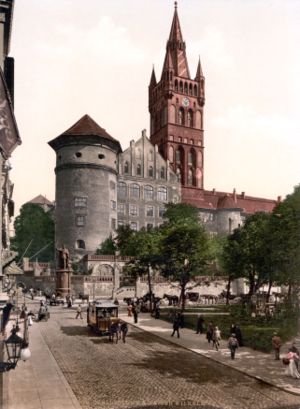Königsberg (until 1936 officially: Königsberg i. Pr.) is the former name of Kaliningrad (Калинингра́д) in the Russian Federation. It was the easternmost large city in Germany until it was captured by the Soviet Union near the end of World War II.The literal meaning of the city's old name is 'King's Mountain'. In the local Low German dialect, spoken by many of its German former inhabitants, the name was Königsbarg (pronounced [ˈkʰeˑnɪçsbɒɐç]). Further names included Russian "Кёнигсберг" Old Prussian: Kunnegsgarbs, Knigsberg, Lithuanian: Karaliaučius, Polish: Królewiec, and the modern Russian and current official name, Kaliningrad.Königsberg was founded in 1255 on the site of the ancient Old Prussian settlement Twangste by the Teutonic Knights during the Northern Crusades, and was named in honour of King Ottokar II of Bohemia. A Baltic port, the city successively became the capital of their monastic state. From 1525 it was the capital of the Duchy of Prussia until the capital was moved to Berlin in 1701. From then until 1945, it was the regional capital of the Prussian and later German province of East Prussia.A university city, home of the Albertina University (founded in 1544), Königsberg developed into an important German intellectual and cultural centre, being the residence of Simon Dach, Immanuel Kant, Käthe Kollwitz, E. T. A. Hoffmann, David Hilbert, Agnes Miegel, Hannah Arendt, Michael Wieck and others.Between the thirteenth and the twentieth centuries, the inhabitants spoke predominantly German, but the multicultural city also had a profound influence on the Lithuanian and Polish cultures. The city was a publishing centre of Polish language literature and of Polish Lutheranism. The first Polish translation of the New Testament was printed in the city in 1551. Also, the first book in Lithuanian language and the first Lutheran catechism were both printed in Königsberg in 1547.Under Nazi rule, the Polish and Jewish minorities were classified as subhumans and persecuted by the authorities. The city housed thousands of Nazi slave labourers during the Second World War, including Russian prisoners of war.By the end of the war, Königsberg was heavily damaged by Allied bombing in 1944 and during its siege in 1945. The city was captured and annexed by the Soviet Union. Its German population mostly expelled, and the city was repopulated with Russians and others from the Soviet Union. Briefly Russified as Kyonigsberg (Кёнигсберг), it was renamed "Kaliningrad" in 1946 in honour of Soviet leader Mikhail Kalinin. It is now the capital of Russia's Kaliningrad Oblast, an area completely cut off by land from the rest of Russia.




Comment
0